APAF1-Binding Long Noncoding RNA Promotes Tumor Growth and Multidrug Resistance in Gastric Cancer by Blocking Apoptosome Assembly
- PMID: 35975461
- PMCID: PMC9534967
- DOI: 10.1002/advs.202201889
APAF1-Binding Long Noncoding RNA Promotes Tumor Growth and Multidrug Resistance in Gastric Cancer by Blocking Apoptosome Assembly
Abstract
Chemotherapeutics remain the first choice for advanced gastric cancers (GCs). However, drug resistance and unavoidable severe toxicity lead to chemotherapy failure and poor prognosis. Long noncoding RNAs (lncRNAs) play critical roles in tumor progression in many cancers, including GC. Here, through RNA screening, an apoptotic protease-activating factor 1 (APAF1)-binding lncRNA (ABL) that is significantly elevated in cancerous GC tissues and an independent prognostic factor for GC patients is identified. Moreover, ABL overexpression inhibits GC cell apoptosis and promotes GC cell survival and multidrug resistance in GC xenograft and organoid models. Mechanistically, ABL directly binds to the RNA-binding protein IGF2BP1 via its KH1/2 domain, and then IGF2BP1 further recognizes the METTL3-mediated m6A modification on ABL, which maintains ABL stability. In addition, ABL can bind to the WD1/WD2 domain of APAF1, which competitively prevent cytochrome c from interacting with APAF1, blocking apoptosome assembly and caspase-9/3 activation; these events lead to resistance to cell death in GC cells. Intriguingly, targeting ABL using encapsulated liposomal siRNA can significantly enhance the sensitivity of GC cells to chemotherapy. Collectively, the results suggest that ABL can be a potential prognostic biomarker and therapeutic target in GC.
Keywords: ABL; IGF2BP1; apoptosis; apoptotic protease-activating factor 1 (APAF1); drug resistance; gastric cancer; m6A.
© 2022 The Authors. Advanced Science published by Wiley-VCH GmbH.
Conflict of interest statement
The authors declare no conflict of interest.
Figures
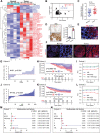
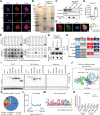

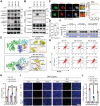
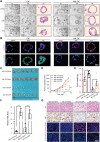
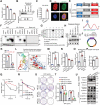

Similar articles
-
Targeting the BAG2/CHIP axis promotes gastric cancer apoptosis by blocking apoptosome assembly.Front Immunol. 2025 Jul 18;16:1578416. doi: 10.3389/fimmu.2025.1578416. eCollection 2025. Front Immunol. 2025. PMID: 40755756 Free PMC article.
-
Loss of WD2 subdomain of Apaf-1 forms an apoptosome structure which blocks activation of caspase-3 and caspase-9.Biochimie. 2021 Jan;180:23-29. doi: 10.1016/j.biochi.2020.10.013. Epub 2020 Oct 24. Biochimie. 2021. PMID: 33132160
-
MicroRNA-17-mediated down-regulation of apoptotic protease activating factor 1 attenuates apoptosome formation and subsequent apoptosis of cardiomyocytes.Biochem Biophys Res Commun. 2015 Sep 18;465(2):299-304. doi: 10.1016/j.bbrc.2015.08.028. Epub 2015 Aug 8. Biochem Biophys Res Commun. 2015. PMID: 26265044
-
A molecular view on signal transduction by the apoptosome.Cell Signal. 2012 Jul;24(7):1420-5. doi: 10.1016/j.cellsig.2012.03.007. Epub 2012 Mar 13. Cell Signal. 2012. PMID: 22446004 Review.
-
[The role of the apoptosome in the activation of procaspase-9].Postepy Hig Med Dosw (Online). 2013 Feb 6;67:54-64. doi: 10.5604/17322693.1032333. Postepy Hig Med Dosw (Online). 2013. PMID: 23475483 Review. Polish.
Cited by
-
Extracellular vesicles in gastric cancer: role of exosomal lncRNA and microRNA as diagnostic and therapeutic targets.Front Physiol. 2023 Aug 16;14:1158839. doi: 10.3389/fphys.2023.1158839. eCollection 2023. Front Physiol. 2023. PMID: 37664422 Free PMC article. Review.
-
LncRNA in gastric cancer drug resistance: deciphering the therapeutic strategies.Front Oncol. 2025 Apr 1;15:1552773. doi: 10.3389/fonc.2025.1552773. eCollection 2025. Front Oncol. 2025. PMID: 40236651 Free PMC article. Review.
-
Regulatory mechanisms and therapeutic implications of insulin-like growth factor 2 mRNA-binding proteins, the emerging crucial m6A regulators of tumors.Theranostics. 2023 Jul 24;13(12):4247-4265. doi: 10.7150/thno.86528. eCollection 2023. Theranostics. 2023. PMID: 37554271 Free PMC article. Review.
-
TREM2 promotes macrophage polarization from M1 to M2 and suppresses osteoarthritis through the NF-κB/CXCL3 axis.Int J Biol Sci. 2024 Mar 11;20(6):1992-2007. doi: 10.7150/ijbs.91519. eCollection 2024. Int J Biol Sci. 2024. PMID: 38617547 Free PMC article.
-
Glucose homeostasis controls N-acetyltransferase 10-mediated ac4C modification of HK2 to drive gastric tumorigenesis.Theranostics. 2025 Jan 20;15(6):2428-2450. doi: 10.7150/thno.104310. eCollection 2025. Theranostics. 2025. PMID: 39990211 Free PMC article.
References
-
- a) Chen W., Zheng R., Baade P. D., Zhang S., Zeng H., Bray F., Jemal A., Yu X. Q., He J., Ca‐Cancer J. Clin. 2016, 66, 115; - PubMed
- b) Ferlay J., Colombet M., Soerjomataram I., Mathers C., Parkin D. M., Pineros M., Znaor A., Bray F., Int. J. Cancer 2019, 144, 1941; - PubMed
- c) Smyth E. C., Nilsson M., Grabsch H. I., van Grieken N. C., Lordick F., Lancet 2020, 396, 635. - PubMed
-
- Wang Q., Xiong J., Qiu D., Zhao X., Yan D., Xu W., Wang Z., Chen Q., Panday S., Li A., Wang S., Zhou J., Int. J. Biochem. Cell Biol. 2017, 92, 164. - PubMed
-
- a) Kang Y. K., Chin K., Chung H. C., Kadowaki S., Oh S. C., Nakayama N., Lee K. W., Hara H., Chung I. J., Tsuda M., Park S. H., Hosaka H., Hironaka S., Miyata Y., Ryu M. H., Baba H., Hyodo I., Bang Y. J., Boku N., Lancet 2020, 21, 1045; - PubMed
- b) Shitara K., Van Cutsem E., Bang Y. J., Fuchs C., Wyrwicz L., Lee K. W., Kudaba I., Garrido M., Chung H. C., Lee J., Castro H. R., Mansoor W., Braghiroli M. I., Karaseva N., Caglevic C., Villanueva L., Goekkurt E., Satake H., Enzinger P., Alsina M., Benson A., Chao J., Ko A. H., Wainberg Z. A., Kher U., Shah S., Kang S. P., Tabernero J., JAMA, J. Am. Med. Assoc. Oncol. 2020, 6, 1571; - PMC - PubMed
- c) Hong C., Wang D., Liang J., Guo Y., Zhu Y., Xia J., Qin J., Zhan H., Wang J., Theranostics 2019, 9, 4437. - PMC - PubMed
Publication types
MeSH terms
Substances
Grants and funding
- 82073114/National Natural Science Foundation of China
- 81903085/National Natural Science Foundation of China
- 81773383/National Natural Science Foundation of China
- 82102984/National Natural Science Foundation of China
- 82103266/National Natural Science Foundation of China
- 2020T130291/China Postdoctoral Science Foundation
- 2019M651808/China Postdoctoral Science Foundation
- 2020M681562/China Postdoctoral Science Foundation
- BK20170047/Science Foundation for Distinguished Young Scholars of Jiangsu Province
- 021414380439/Fundamental Research Funds for the Central Universities
- JQX21005/Nanjing special foundation for health science and technology development distinguished young program
LinkOut - more resources
Full Text Sources
Medical
Molecular Biology Databases
Research Materials
Miscellaneous
